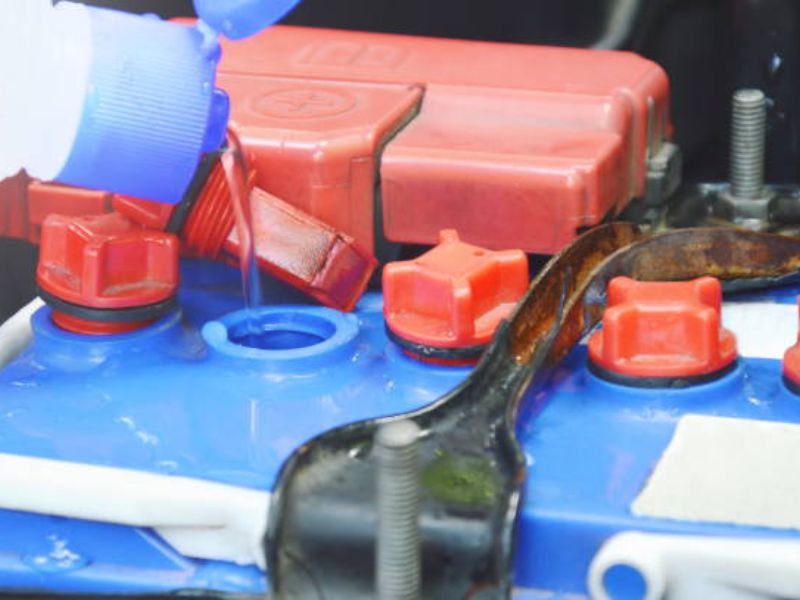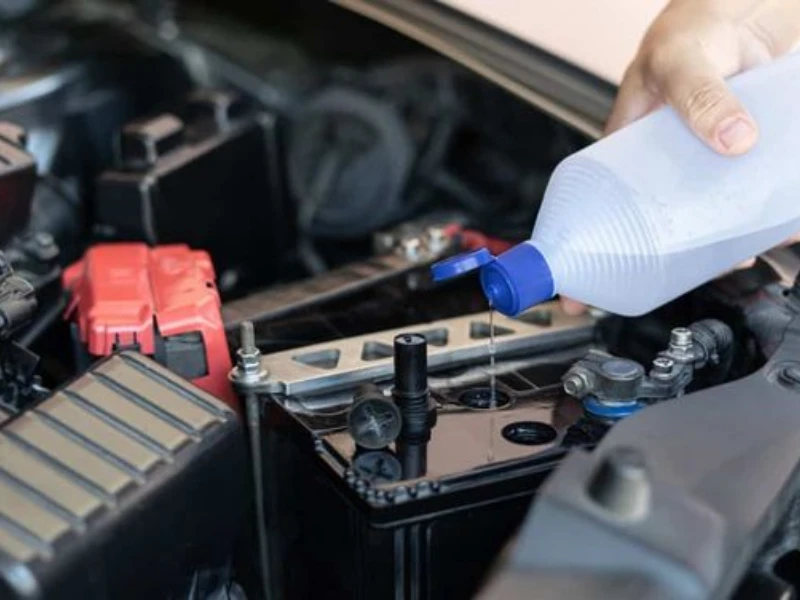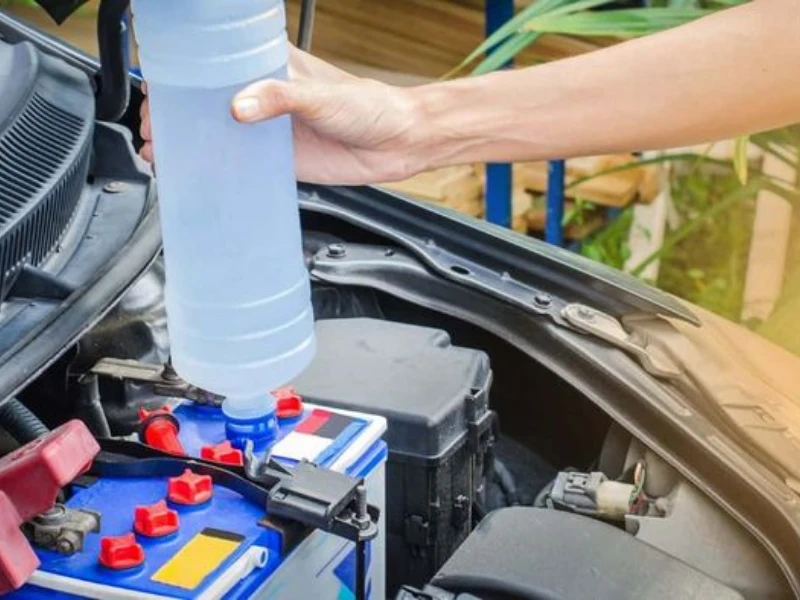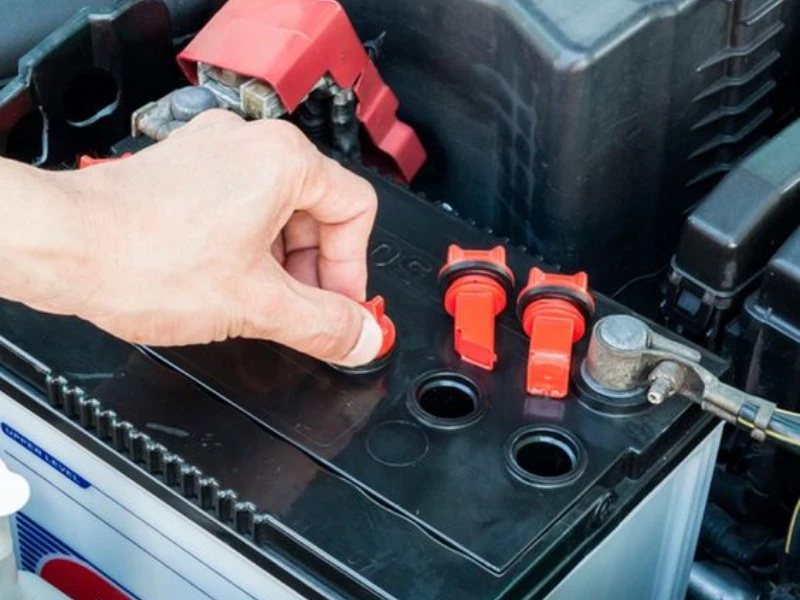The Role of Electrolytes in Lead-Acid Batteries
When it comes to the ‘juice’ that powers your car batteries, or lead-acid batteries to be specific, electrolytes play an unignorable role. These electrolytes are often a mixture of sulfuric acid and distilled water. You might think, “Ah, just water and acid… I mean, how complex could it be?” But, let’s hold our horses… or in this case, our electrons!
Electrolytes in a lead-acid battery serve as a medium through which current flows—specifically, between the lead and lead dioxide (the electrodes). The electrolyte solution initiates a reaction between the electrodes, leading to the production of an electric current. When the battery discharges, lead sulfate is produced, and water is a byproduct. As a result, the electrolyte level can decrease over time due to the conversion of water into hydrogen and oxygen gases which may evaporate.
The balance between battery acid (sulfuric acid) and water in the electrolyte solution is critical. Too much sulfuric acid can cause corrosion on the battery terminals, while too much water can dilute the acid and impair the battery’s ability to produce electrical energy. So you see, it’s not as simple as it may seem!
Understand the role of electrolytes now? Great, let’s move on!

What is Battery Acid?
Often when we talk about “battery acid,” we’re talking about sulfuric acid, a key component in lead-acid batteries. Now, don’t let the word ‘acid’ give you the heebie-jeebies! With the right protective clothing, handling it safely is a breeze.
Sulfuric acid is a strong acid, and when combined with water, it creates the electrolyte solution necessary for the battery’s operation. This battery acid is vital for the chemical reactions that allow the battery to store and discharge energy.
But remember, folks, battery acid isn’t something you’d want to mess around with. It’s corrosive and can cause burns, so always handle it with care. Even an old battery can have residual sulfuric acid, which needs careful disposal.
What is Distilled Water?
If you’ve ever taken a gander at battery maintenance guidelines, you might’ve come across the term “distilled water.” But what exactly is it?
Distilled water is, essentially, pure water. It’s water that has gone through a process of distillation, removing any impurities or minerals. Unlike tap water or soda, distilled water is devoid of any additional substances.
Now, you might ask, “Why distilled? Can’t we just use tap water?” The answer is a resounding no! Tap water contains minerals and other impurities that can react with the sulfuric acid in the battery. These reactions can create unwanted substances that can hinder the proper functioning of the battery. In other words, tap water and car batteries are not the best of friends!

What are the Functions of Battery Acid?
Back to our friend, the battery acid. So, we know it’s vital for the operation of the battery, but what does it do, exactly? Well, let’s take a closer look.
Battery acid, or sulfuric acid, is the main component of theelectrolyte in a lead-acid battery. It interacts with the lead plates inside the battery, producing lead sulfate and creating energy in the process. A simple analogy? It’s like fuel for your battery!
Apart from energy production, battery acid also helps maintain the water level (Learn: What is the Battery Acid PH Level?) in the battery. As the battery discharges, the sulfuric acid reacts with water to produce hydrogen ions. These hydrogen ions then react with the battery’s lead plates, producing lead sulfate and water.
What are the Functions of Distilled Water?
Distilled water plays a crucial role in maintaining the health and efficiency of your battery. It’s used to top up the electrolyte level in the battery to compensate for water loss due to evaporation or the discharging process.
You see, the water level in your lead-acid battery isn’t just for show. A low water level can expose the lead plates, leading to their sulfation and, consequently, reducing the battery’s lifespan. Therefore, distilled water is like a lifeguard for your battery, saving it from potential damage!
By using distilled water, which is free from impurities and minerals, you can help prolong the lifespan of your battery and keep it running smoothly.
So far so good? Now, let’s move on to the differences between battery acid and distilled water.

What are the Differences? Battery Acid Vs Distilled Water
Alright, let’s get into the nitty-gritty of battery acid vs distilled water. Though they might seem similar, there are quite a few differences that set them apart. Let’s unpack it!
PH levels
Remember when we were talking about sulfuric acid being a strong acid? Well, that’s evident in its PH levels. Battery acid has a low PH, making it highly acidic. On the other hand, distilled water, being pure H2O, has a neutral PH level of 7.
Electrolytes
Here’s a biggie: Battery acid acts as an electrolyte in lead-acid batteries. It conducts electricity and takes part in chemical reactions within the battery. Distilled water, while a component of the electrolyte solution, is not an electrolyte in itself and does not participate directly in the energy production process.
Corrosive nature
Battery acid, with its high acidity, is corrosive and can cause burns or damage to materials it comes into contact with. Distilled water, however, is benign and non-corrosive.
Application
While both battery acid and distilled water are crucial to a lead-acid battery, their roles are different (Related Article: LiFePO4 Battery vs Lead-acid Battery). Battery acid is responsible for energy production, while distilled water is used for maintaining the electrolyte level in the battery.
Here’s a quick table to help you visualize these differences:
| Battery Acid | Distilled Water | |
| PH Levels | Low (Acidic) | 7 (Neutral) |
| Electrolytes | Acts as an electrolyte | Not an electrolyte |
| Corrosive nature | Yes | No |
| Application | Energy production | Maintaining electrolyte level |
When to Use Battery Acid and Distilled Water?
Battery acid and distilled water, despite their differences, share a common purpose: ensuring your battery runs smoothly. Battery acid is required for the chemical reactions that create energy within the battery. Therefore, it’s an essential component of a new battery or when replacing the electrolyte solution in an old battery.
Distilled water, on the other hand, is primarily used for maintenance. Over time, due to evaporation and the discharge process, the water level in the battery decreases. This is when distilled water comes to the rescue! Regularly checking and topping up the battery water level with distilled water helps maintain the electrolyte concentration and prevent sulfation of the lead plates.

How often should the battery acid or distilled water levels be checked?
Maintaining your lead-acid battery isn’t a “set it and forget it” affair. Nope, far from it! It involves regular checks to ensure everything is working as it should.
The frequency of checking your battery’s fluid levels (i.e., battery acid and water) depends on several factors, including the type of battery and its usage. Generally, it’s recommended to check the levels every 3-6 months. However, if your battery discharges frequently or operates under high-temperature conditions, more frequent checks might be necessary to prevent water loss from evaporation.
Maintenance-free batteries, as the name suggests, require less maintenance. Thanks to advancements in technology, battery manufacturers have designed these batteries to minimize water loss, hence reducing the need for regular topping up. Nevertheless, occasional checks wouldn’t hurt!
Here’s a helpful table to guide you:
| Battery Condition | Check Frequency |
| Normal usage | Every 3-6 months |
| Frequent discharges or high-temperature operation | More frequently |
| Maintenance-free batteries | Occasionally |
Conclusion
The debate of battery acid vs distilled water is like comparing apples and oranges, or rather, comparing electrolytes and their components. Each plays a distinct role in a lead-acid battery. Battery acid (sulfuric acid) is an integral part of the electrolyte solution, participating in the chemical reactions that produce electricity. Distilled water, on the other hand, helps maintain the electrolyte level, ensuring the smooth operation and longevity of the battery.
By understanding the roles and functions of battery acid and distilled water, you’ll be better equipped to maintain your battery effectively. Remember, regular checks and top-ups with distilled water can go a long way in preserving your battery’s health and efficiency (learn: How to Charge RV Battery Efficiently [5 Ways]).
And there we have it! A deep dive into the world of batteries. Who knew something as simple as acid and water could be so… electrifying, right? Here’s to keeping your battery in tip-top shape!

